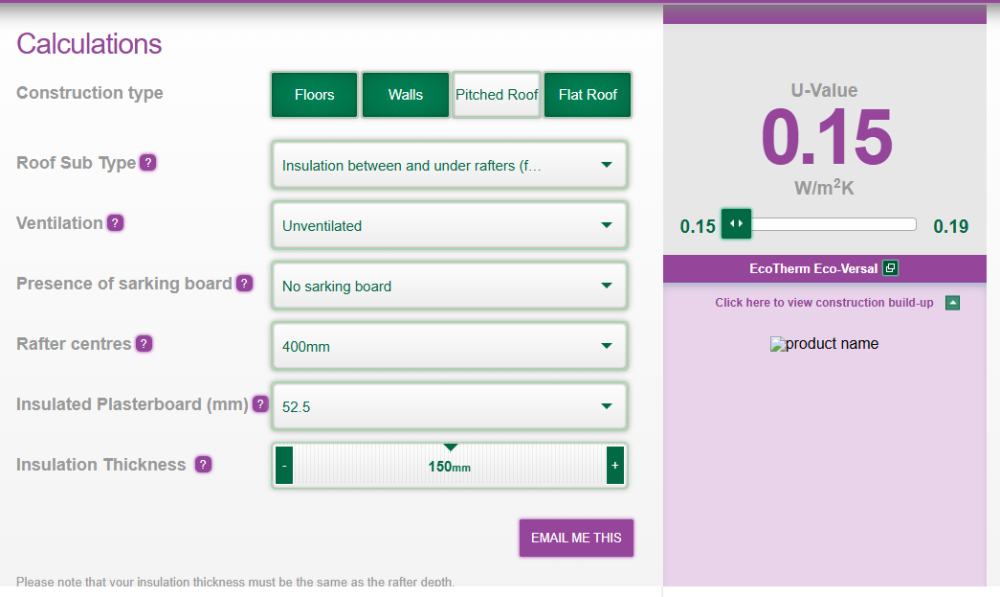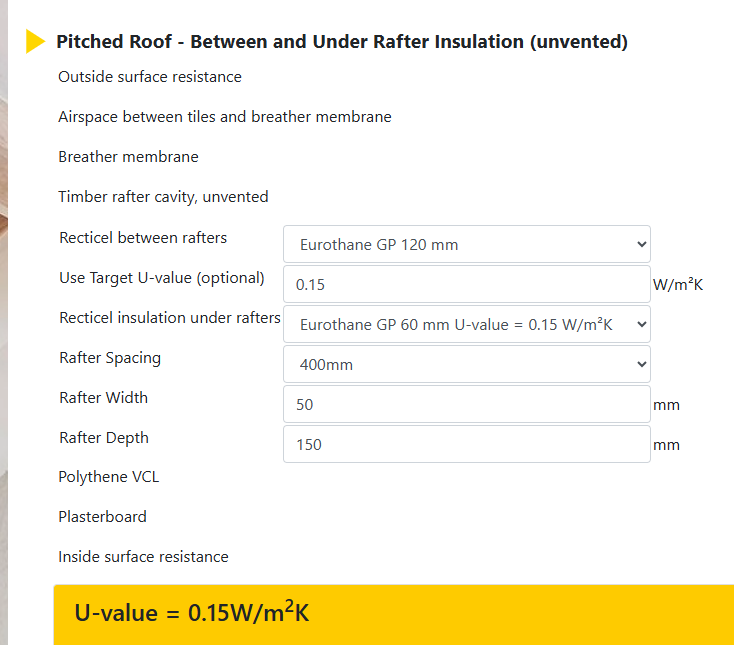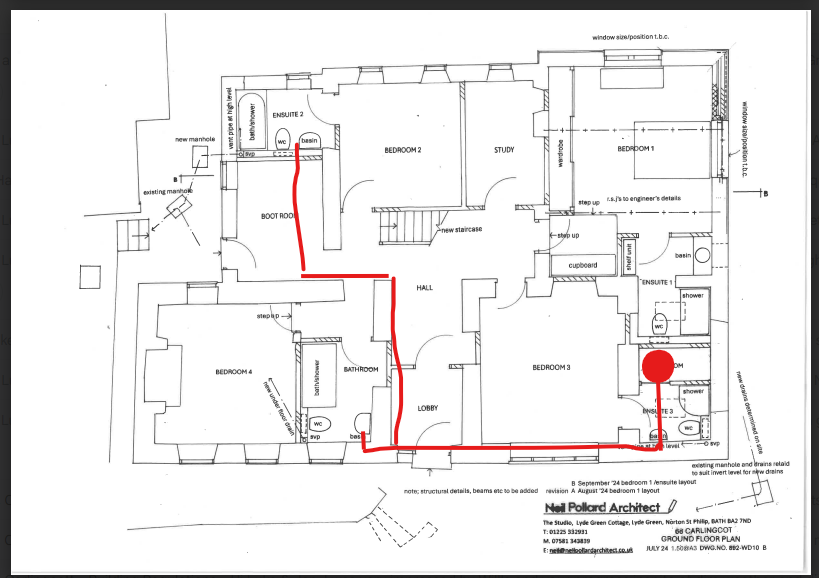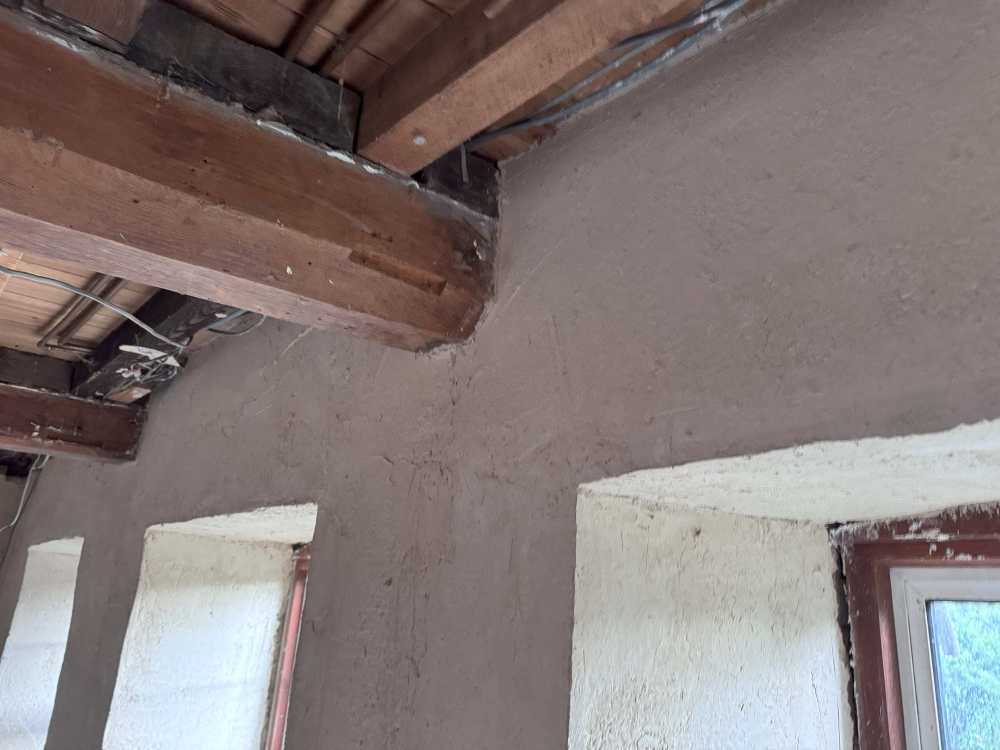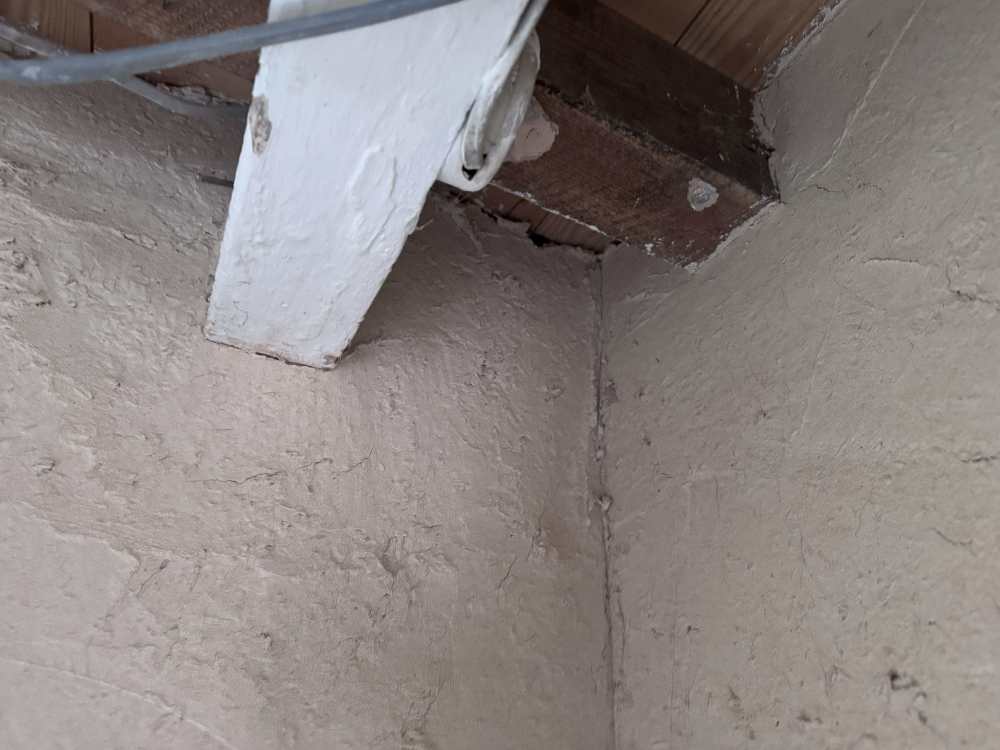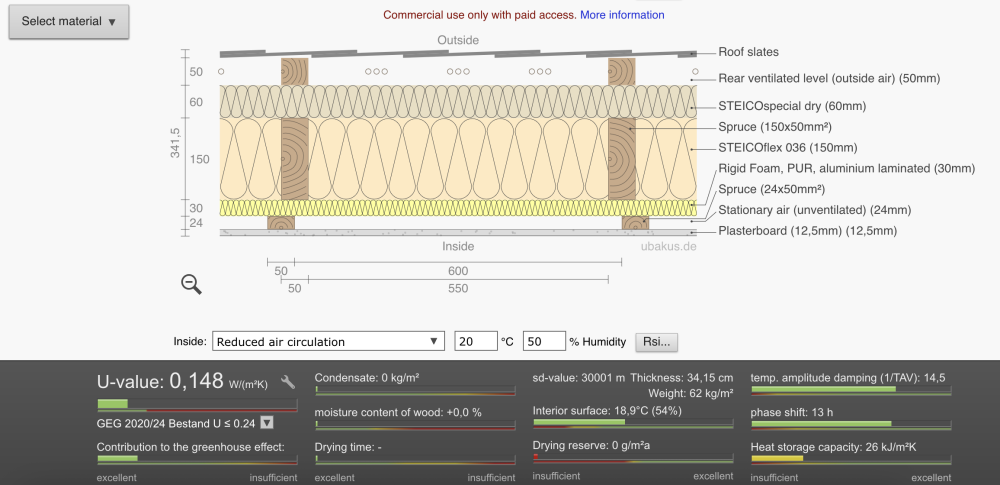
lookseehear
Members-
Posts
149 -
Joined
-
Last visited
Everything posted by lookseehear
-
Couldn’t you have your tilt fillet a bit back from the fascia so that it’s taking the weight of the slate?
-
Not sure if you've solved this yet but I don't think having a tilting fillet stops you doing over-fascia ventilation. See the below from LABC.
-
You're right I'm probably looking at this the wrong way round. I'm likely being swayed by the fact our current EV only has a 24kWh battery and needs charging often and sometimes during the day, whereas most newer EVs have bigger batteries and can be charged overnight almost all of the time. There are definitely times during the day where someone would want to 'top up' an EV with a larger battery, for example just before a long trip where you want to have max range to start with. The issue with using the car battery to buffer the house demand or grid is unnecessary battery cycling - no one will want their car battery devalued or degraded. But I agree that having an 80-100 kWh battery sat on the driveway seems a bit of a waste if you can set it to better use.
-
It's really hard to tell whether these things will happen at the same time. Low overnight rates is a product of low demand vs peak hours, but I don't know how much more the adoption needs to increase until it becomes relatively higher demand and therefore has a cost impact to the consumer. The good thing is demand is predictable and relatively stable (and growing) which I think will contribute to keeping prices lower. Solar's problems are that it's seasonal and unpredictable and peak generation is rarely when consumers want to use it. Without the demand from consumers, it's more likely to be that we see a lot more 'free' energy during the sunnier seasons to balance the load, which will likely have a greater impact on the feed in rates because you can only buy something for 15p and sell it for nothing to a certain point. My guess is that feed in rates will drop before overnight rates increase, but who knows. I'm not proposing to dump all the power from the battery into the car, but I'm thinking that with some moderate sun it would make sense to supplement solar production with a battery for a short charge during the day.
-
My understanding (happy to be corrected) is that if I have a fully charged 10kWh battery and a 5kW inverter, I can only draw 5kW from the battery. This would mean that if I plug in my car to the 7kW charging point, I would have to 'buy' 2kW from my electricity supplier rather than use what I have in the battery. Another scenario is that it's full sunshine and the panels are generating 5kW and I plug the car in, I can't do 5kW from the panels and 2kW from the battery without a bigger inverter. I believe the panels and battery are DC, but the inverter is required to convert to AC for use in the house or for selling back to the grid.
-
Maybe I need to look more at tariffs. My assumption in the future is that export rates will reduce as more people get solar, because they'll all peak at the same time and at that time the generation will greatly exceed energy requirements. Other than being future proof, why look for a system which doesn't require internet? I imagine internet is only for some smart features, not for basic functionality? the one who offered 3 or 5 said the 5 would be a 'small additional cost' and the 8kW one didn't mention but I assume would get consent as part of the install. In the event we want to charge during the day (and if we have 2 EVs that might be more of a common occurrence), it would make sense to use stored energy in the battery wouldn't it? If I have a 3kW inverter and charge at 7kW I need to import 4kW from the grid at peak rates. Sorry if I've misunderstood. Not sure I agree - charge at 7-8p/kWh, get ~3miles/kWh efficiency means ~2-3p/mile plus 3p new tax still makes it probably half the price per mile of a petrol or diesel. Things will change though over time. Personally I hope someone manages to reform the UK energy market to enable cheaper electricity from renewable sources.
-
I've had a couple of quotes for solar + battery + associated hardware and have three options on the table. We're looking at a 5kW array and probably a 10kWh battery. The options are SolarEdge or Libbi from one installer, or GivEnergy from another. The main difference that I can see is the first installer is offering a 3kW or 5kW inverter whereas the GivEnergy is 8kW. We have a small EV but we'll likely get a bigger one when all the work is done, so I'm leaning towards the GivEnergy. We're also expecting to put in a 10-12kW heat pump as part of our renovation and a >200l UVC. We're on Intelligent Octopus Go at the moment with a SyncEnergy 7kW charger, which I'd rather not replace but would do if it meant managing the whole system was easier. I'm not really sure how I'm meant to choose between these three options. Are there any obvious good or bad choices here? Ideally I'd like a system that can manage import/export, dump excess solar into EV/DHW and be as future proof as possible.
-
Using multifoil under steico insulated roof
lookseehear replied to lookseehear's topic in Heat Insulation
It’s a brand new roof, so it’s actually less of a retrofit. Rafters are 150mm. i think you’re right that the risk is higher, I just can’t work out how much higher and if it’s allowable by Recticel etc then maybe the risk is mitigated by decent breather membranes and a small amount of ventilation from counter battening and not having the insulation jammed against the breather. -
Using multifoil under steico insulated roof
lookseehear replied to lookseehear's topic in Heat Insulation
Any thoughts here? -
Using multifoil under steico insulated roof
lookseehear replied to lookseehear's topic in Heat Insulation
I've checked with the SE and no sarking board or 'racking' layer required. I'm thinking about taking the simple route here and going with PIR between and under the rafters. I've been on a few websites (ecotherm, recticel etc) and they seem to indicate that a 50mm ventilation gap isn't required providing a breather membrane is used, but that maybe you need to leave at least 25mm of rafter 'unfilled' and potentially counterbatten as well. Ecotherm calc below showing 'fully filled' with 150mm PIR, with 40mm underneath to get to 0.15, and Recticel only showing 120mm in 150mm rafter. Is going 'unvented' a bit of a risk or are modern breather membranes combined with a good VCL underneath sufficient to ensure no risk of condensation? -
Long hot pipe runs (second HW cylinder?)
lookseehear replied to lookseehear's topic in Bathrooms, Ensuites & Wetrooms
Thanks for the response. I'm really hesitant to move the DHW cylinder - we've got a dedicated plant room already constructed and drains in place for bathrooms. I like the idea of a manifold and will have a think on that. I'm not that keen on the smart plug idea - they always feel like a good solution to short term problems to me, and I don't want an Amazon device in my house. Given the complexity of the job (heating included) I'm leaning towards speaking to a local HeatGeek certified installer (potentially under their 'black label' service) for the heating and DHW plumbing. -
We're starting to plan pipe runs for new bathrooms in our extension/renovation project - as a reminder everything is moving around due to going upside-down and house is being rewired/replumbed. DHW cylinder is going in a small plant room in one of the new extensions which is on the corner of the house. In total the hot water requirements are the kitchen plus 3 shower rooms (ensuites), one 'family' bathroom mostly used by guests and one small WC. The bathroom layouts in the below sketch are not correct, but the room positions have not changed. The red circle is DHW cylinder and the red lines are likely HW pipe runs to 'family' bathroom, ensuite 2 (shower room) and the kitchen which is above the boot room and Ensuite 2. I had assumed we would run 22mm for all the main pipe runs and branch off to 15mm to maintain flow, but I've now realised that in the kitchen that could be a 15m+ pipe run in 22mm and would take half a day for hot water to appear at the tap, and the same problem in ensuite 2 and (to a lesser extent) in the family bathroom. What I want to try and avoid is the shower in bathroom 2 being severely affected by the kitchen hot tap being used. I know that we won't be able to use all the showers simultaneously, but I'd like to be able to use any two at once. I can see a few solutions but maybe there's one I'm not aware of: Use 15mm instead of 22mm from where the pipe branches off near the front door to the back of the house to serve the kitchen and ensuite 2. This would lessen the delay overall, but with less more restricted flow to the back of the house, the shower would be more likely to be impacted by the kitchen tap? Run two 15mm hot branches (or one 15mm and one 12mm) from the 22mm running along the front of the house to the back of the house. the 15mm just to the shower in ensuite 2 and the 15mm/12mm to the kitchen tap and ensuite 2 basin. This might isolate the shower from the sink more effectively and reduce delay for hot water to the kitchen/ensuite sinks. A second small hot water tank with an immersion under the sink to feed the kitchen hot tap and the hot tap in the shower room and run 15mm from the front just for the shower in ensuite 2. This would decouple the kitchen from the ensuite shower and mean close to instant hot water at the taps in the kitchen and ensuite. I've seen the heat geek mini store and wondered if I could put that in a corner kitchen cabinet in addition to the main DHW cylinder in the plant room. The mini store could run the kitchen and the ensuite shower/taps. I've no idea if this is even possible - planning to put in an ASHP as part of the building work and don't know if/how it's possible to run two cylinders on opposite sides of the house in parallel from one ASHP. i know I have a tendency to overcomplicate things, but unfortunately that's just the way my brain works - I'm thinking through all the options at the moment. Any feedback?
-
Fine tuning my IWI Solid wall (Warm Batten) design
lookseehear replied to Annker's topic in Heat Insulation
I just wanted to pick up on this point. It's often not useful to compare internal and external RH's because of the temperature difference. You may know this already, so sorry if I'm teaching you to suck eggs! 95% RH at 15 degrees is roughly 70% RH at 20 degrees, which is why opening windows to allow colder external air in is almost always going to help dry a house out. If your internal warm air is 95% RH then that's much more likely to be a sign of a problem (water coming from another source). I've lost count of the amount of times during the winter I've seen people posting online saying that they won't open their windows because the weather shows it's 100% humidity outside, when in reality 100% humidity during a cold spell will give lovely dry air once warmed up to room temperature. -
Fine tuning my IWI Solid wall (Warm Batten) design
lookseehear replied to Annker's topic in Heat Insulation
I have got some airtight tape and haven't got any airtight paint which is steering my decision! Here are some pics of what I've done. -
Fine tuning my IWI Solid wall (Warm Batten) design
lookseehear replied to Annker's topic in Heat Insulation
What I've been doing is using lime hemp plaster (pre bagged from Ty Mawr) to fill these gaps with some appropriately sized stones. Basically find a stone that nearly fits, put some lime plaster in and then push the stone into place, then cover the lot with more lime plaster around the joists. I'm then going to airtight tape the joists back to the plaster. It's been a lot harder than I thought in an old house. You take the ceiling down and there are voids in the wall all over the place. -
Using multifoil under steico insulated roof
lookseehear replied to lookseehear's topic in Heat Insulation
I don't plan on making the roof vapour permeable from the inside, and am planning a VCL under the rafters to achieve this. The Steico is for decrement delay reasons as well as 'better for the planet' reasons. It's hard to know how a space is going to react in the heat of summer, but it would suck to go through all of this then feel we need some kind of cooling solution when we could have fixed it with an insulation that performs better vs heat. Steico's standard roof buildup doesn't seem to include a structural board for racking, but I imagine it's probably preferable? How do you find your roof performs on hot days? -
Using multifoil under steico insulated roof
lookseehear replied to lookseehear's topic in Heat Insulation
Haven't decided but am leaning towards LED strips recessed along the top of the walls which will illuminate the vaulted ceiling upwards - we're creating a battened insulated service void against the walls, so there should be a neat spot to do this. Service void in the vaulted ceiling was more for flexibility but maybe we don't need it. I was going to use multifoil taped to parged walls as VCL/airtightness layer on the inside of rafters but if I do PIR underneath I would assume that a continuous layer with joints taped and taped back to parged wall would be sufficient. Steico flex is (from my understanding) easy to fit between rafters in a snug way (held in place with battens), and over-boarding with steico special dry sarking board. I understand a breather membrane isn't required over steico special dry, but Ecomerchant said it's probably a good idea in case any of the tongue and groove joints are damaged. Concrete pads are in to take roof steels which are being measured for next week and hopefully installed in September. These will be on top of existing roof, so that roof timbers can go on top and the existing roof can be removed in a phased way. -
Using multifoil under steico insulated roof
lookseehear replied to lookseehear's topic in Heat Insulation
This would get me to required U value with at least 30mm PIR under the rafters. Am I right in thinking that any cables within service void need to be 50mm back from the surfact, so would need thicker batten? -
Using multifoil under steico insulated roof
lookseehear replied to lookseehear's topic in Heat Insulation
Just to check you mean PIR under the rafters but still to use Steico within and above the rafters rather than PIR for the whole lot? The reason I didn't want to do this is it removes the service void, but I guess we could just add a service void below the PIR and put the plasterboard on battens. -
Using multifoil under steico insulated roof
lookseehear replied to lookseehear's topic in Heat Insulation
I should probably be clear that when I say spray foamed, I mean the PIR would be cut close to size and any gaps spray foamed so there are no issues with the PIR being cut accurately to the gaps between rafters. He doesn’t want to use spray foam as the insulation. I don’t think the architect said thermal mass, I can’t remember the exact wording. Does it matter? The living space is upstairs with vaulted ceilings, but the roof pitch is low, so floor to inside of the ridge is roughly 3m. -
We’re in the final stages of planning our re-roof. The engineer has specified 150 mm rafters, supported by a steel ridge beam. Our architect is encouraging us to use wood fibre insulation for its thermal mass and decrement delay (since the main living space will be upstairs), which I’m increasingly drawn to. The builder, however, would prefer PIR spray-foamed between the rafters, with multifoil stapled underneath, counter-battened to create a service void, and finished with plasterboard and skim. We’re already raising the roof height slightly beyond what was approved in planning (approval was for a 200 mm increase). If we fully fill the rafters with Steico Flex, plus add 60 mm of Steico Special Dry sarking board on top, we achieve roughly a 0.19 W/m²K U-value. I think adding multifoil underneath could bring us down to the required 0.15, while also serving as a vapour control layer—and it would keep the builder happy. My understanding is that multifoil requires a low-emissivity cavity, which in practice means leaving an air gap between the multifoil and the plasterboard. Still, it feels unusual to see it specified as part of a roof build-up. Am I missing something here? Are there obvious alternatives I should be considering?
-
Old Property Reroofing to Warm Roof Advice
lookseehear replied to Lears's topic in Roofing, Tiling & Slating
Hijacking this rather than starting a new thread because we'll be doing something similar. What I was hoping to do was fully fill 150mm joists with steico flex and overlay with 60mm Steico special dry sarking board, but this only gets me in the region of 0.18-0.19 when I need to hit 0.15 for new element in existing building. The builder has suggested counterbattening under the joists and using multifoil/superfoil within the unventilated cavity (which will also work as a service void) then plasterboard and skim underneath. The multifoil will also act as the VCL in this case. I'm struggling to model multifoil in Ubakus - anyone got any tips on this hybrid approach? Edit: ChangePlan's U value calculator seems to get me to 0.14 using Superfoil SF19BB under the rafters, but seems to want 40mm as a cavity. -
Recommended manufacturers or Installers in the South West?
lookseehear replied to Lears's topic in Windows & Glazing
Have you been to the National Self Build & Renovation Centre in Swindon? You can see many of these brands windows side by side there which might help with making a decision. -
Fine tuning my IWI Solid wall (Warm Batten) design
lookseehear replied to Annker's topic in Heat Insulation
how was it with the sand mix vs sharp sand?



